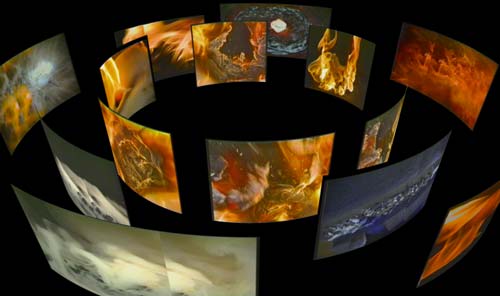 |
|
| |
PYROGLYPHS 1994 |
A VIDEO
MATRIX BY STEINA
IN COLLABORATION WITH TOM JOYCE |
The initial inspiration for Pyroglyphs
was the ancient art of blacksmithing but it soon
became a musical treatise . . . In Steina’s
words: “In 1994 I spent long hours with
blacksmith Tom Joyce, videotaping the process
of building an iron gate. I found iron gates a
little too concrete, so I closed in on the intense
and violent nature of materials being manipulated
by torches, files, and anvils—the rapid
flicker of flames. . . . Tom and I share a fascination
with fire — as a phenomenon and as a medium
that transforms other materials . . . as a medium
of transmutation.”
Steina videotaped, mostly in closeup, the activities
of blacksmithing (hammering, filing, welding,
manipulating fire), the phenomenology of fire
(flames, sparks, combustions, glowing metals),
and various improvised scenes — a vise crushing
a timber, a stack of books burning, paper and
wood being scorched.
Editing this material into three complementary
image tracks was relatively easy (the visuals
were similar or disimilar in compatible ways)
but the sounds of those images were often too
similar or too strident, competing for attention.
So the sounds determined the editing. Steina processed
them through digital devices like harmonizers,
which couldn’t turn the random noises into
harmonics but produced interesting sounds anyway;
pitch shifters that move a sound to the octave
immediately above or below; and reverb circuits
to create echo effects. The sounds and rhythms
are rendered allegro con brio, pianoforte, or
pianissimo: there is a lot of percussive hammering,
say, then all is quiet and we hear only crackling
flame or the hollow whisper of the blowtorch.
. . .
PYROGLYPHS is a spectacular meditation on fire.
Steina has created a sublime landscape illumined
by the many-hued glow of fevered metals and shows
of sparkling scintilla. She makes us feel the
hypnotic pull of lambent flames even as our breath
is caught by the preemptive ignition of the torch,
our hearts quickened by the violence of the forge.
|
| —
GENE YOUNGBLOOD |
|
| |
| D E S C R I P T I O N |
In PYROGLYPHS, fifteen (or eighteen)
monitors are arranged in a circle on the floor
facing up and inward at a 30 degree angle. The
viewer stands outside this circle looking in.
Three channels of video program recorded on laser
disk players provide one video and two audio sources
each routed to a circle of video monitors with
internal speakers (see drawing for assignment).The
laser disk players are aligned by a synchronizer
for synchronous playback. Each player at the end
of its twenty-minute cycle automatically returns
and re-synchronizes for a continuous performance.
|
| |
|
|